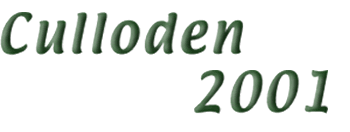
Information,
suggestions, and guidelines for Jacobite participants:
Men's
Clothing
 |
Information,
suggestions, and guidelines for Jacobite participants: Men's
Clothing |
|
MEN'S
CLOTHING: Men wore loose fitting white or off white linen or cotton shirts, hanging to mid thigh. These shirts were open, or buttoned with loops or button holes at the neck and cuffs. The shirts did not lace up like shoes or have metal grommets at the neck. These shirts often fastened between the legs with a button or tie. Shirts doubled as nightshirts for many men of the period. Over the shirt were worn belted plaids (known also as great kilts), or kilts (one half of a belted plaid, lengthwise), or trews (a combination of tights and pants made of tartan wool). The belted plaid or great kilt consists of from four to six yards of roughly 60 inch material (originally two pieces of 20 to 30 inch wide fabric sewn lengthwise). It is worn with hand folded pleats, and is belted, tied, or pinned into place. The belted plaid was your overcoat, pants, rain gear, blanket, tent, backpack, and fire damper. It is one of the most utilitarian garments every invented. Large circular brooches for fastening the great kilt at the shoulder were still in use, but the ones with great big stones are Victorian foofaraw. Please do not wear modern kilt pins to keep the skirt's overlap closed. Highland men wore a wool waistcoat, and a wool coat or jacket. Highland waistcoats and jackets were designed much shorter then the mid 18th Century fashion standard if they were to be worn with a belted plaid or kilt. Animal skins with the hair on them were rarely seen as dress items in the mid 18th Century. A neck stock or neckerchief was worn, as much for protection against sword blades as it was fashion. A lace jabot and cuffs were often seen on gentlemen. Aside from weapons, a belt and sporran (leather purse or bag hung on your belt) complete the traditional Highland outfit. Belts were strong and wide, and were usually very plain. The sporran is a simple leather pouch in which is carried your money and small items, as there are no pockets in a kilt. There are expensive, fancy sporrans out there, but they would be inappropriate for most Highlanders. Many Highland men either went barefoot, or wore gillies (an open, roman like shoe) with up-the-calf ties. Shoes were usually simple brogues with buckles. The brogues would be worn with wool bag socks (seamed up the back) and tied on. Gillies were also sometimes worn with bag socks. Wool leggings (like footless knee socks) were occasionally worn, with or without gillies. Riding boots may have been worn with trews, but boots were not worn with kilts. Class played a large part in footwear. The Highland bonnet was a very important item of clothing in a man's wardrobe. Bonnets were predominantly blue wool (sometimes dark green or dark red), and were not made of tartan. They were usually worn flat on the head and not at a great rakish angle. Bonnets in 1745 were generally at least 12 inches across and did not resemble modern golf hats. Bonnets should be decorated as follows:
Little boys (like little girls) wore shifts, not small versions of men's clothes. Older boys wore clothing like their fathers. As with women, upper class gentlemen wore a wider variety of clothing, of a better grade, and more in tune with the fashions of the day. (back to top) |
|
|
|
|
|
Copyright 2001 MacFarlane's Company. Information on this page may be used by non-profit organizations for research and education purposes only, for all other use contact Elliot MacFarlane. Last updated: 01/03/01 For more information on MacFarlane's Company, contact Elliot MacFarlane: emacfarlane@accesstoledo.com |
|